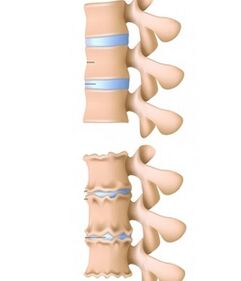
What are the causes of cervical osteochondrosis? What are the symptoms? How to effectively treat osteochondrosis of the cervical spine at home?
Cervical osteochondrosis is one of the common diseases that increasingly affects young people (25 - 40 years old). The development of cervical osteochondrosis is facilitated by a prolonged stay in the bad tense posture - for example, working at a computer during the day or making a habit of supporting the telephone receiver with the shoulder.
It is often caused by prolonged exposure to vibration, for example when working with construction machinery or driving a car. Also, poor posture, uncomfortable bed, sedentary lifestyle, hereditary predisposition and other factors can lead to cervical osteochondrosis.
Cervical osteochondrosis and its causes
Cervical osteochondrosis is a degenerative-dystrophic lesion of the intervertebral disc of the cervical spine. This occurs against the background of metabolic disorders of the cervical spine, in which the structure of the intervertebral discs (special spacers between the vertebrae) and the bodies of the vertebrae themselves change.
In terms of symptoms, cervical osteochondrosis is somewhat different from osteochondrosis in other parts. It is the most dangerous type of osteochondrosis, as it often leads to damage to the root of the nerve extending from the spinal cord and disruption of blood supply to the brain due to compression of the blood vessels. . The reason is the peculiarities of the anatomical structure of the spine in the cervical area. Thus, one of the large arteries supplying the brain - the vertebral - passes precisely through the openings of the processes of the cervical vertebrae. Therefore, their pathological changes - proliferation of bones and fibrous tissues, displacement of the vertebra - lead to disruption of the normal functioning of this artery.
In addition, the very structure of the spine in the cervical column is somewhat different - the vertebrae are more closely adjacent to each other. Therefore, in the event of a pathological change, even insignificant, in one of the vertebrae, the normal functioning of the entire section is disturbed - depression or displacement of nerves and blood vessels, as well as more frequent compression of the spinal cordthan with the lumbar or thoracic vertebrae. osteochondrosis. As a result, with cervical osteochondrosis, significant dysfunctions can be observed - a disorder of the sensitivity of the skin and muscles of the neck, face, hands, attacks of dizziness. There may be noise or ringing in the ears and head, persistent headaches, increased fatigue, blurred vision and hearing, unsteadiness when walking, etc.
Symptoms of cervical osteochondrosis

Among the symptoms of cervical osteochondrosis we note the following:
- Pain in the neck, back of the head, shoulder or arm. In addition, weakness of the muscles of the arms, difficulty with movement of the head, tightening of the neck when rotating or tilting the head to the side is often observed.
- There is often a pulling pain in the left side of the chest, which radiates to the left arm. There may be a burning sensation or pain between the shoulder blades.
- Cervical osteochondrosis causes recurring headaches, a feeling of weakness, and increased fatigue. Typically, the pain is painful in nature and is concentrated on the side and back of the neck, as well as the back of the head. Patients often have difficulty moving their head, especially when it turns in different directions.
- Neck pain may radiate to the arm and spread from the shoulder to the hand with numbness in the fingers. In this case, patients sometimes complain of "itching" or "passing electric current" down the arms and legs when they bend the neck.
- Cervical osteochondrosis can also cause hearing and vision problems, pain in the hands, problems with the functioning of the heart and lungs, dizziness, nausea, double vision, numbness of the face andlanguage.
What is cervical osteochondrosis? What are the symptoms? How to treat cervical osteochondrosis?
Treatment of cervical osteochondrosis
As a rule, cervical osteochondrosis begins in a mild form and does not cause any particular inconvenience to the person at first. Medical treatment at this stage is usually not necessary, it is enough only to prevent further complications, improve working conditions and revise the lifestyle in favor of a healthier lifestyle.
To prevent cervical osteochondrosis, you need to lead an active lifestyle, exercise in the morning, eat a moderate calorie diet, get rid of bad habits and avoid heavy lifting. An upright posture, correct posture when sitting and sleeping, a comfortable bed are also important factors in its prevention. Remedial gymnastics lessons will also be useful.
However, with age, cervical osteochondrosis progresses and can progress to more serious forms. In this case, the treatment of cervical osteochondrosis is carried out by conservative methods. Among them: wearing special collars, physiotherapy, exercise therapy, massage. In more severe cases, the patient may require drug therapy - analgesics, antispasmodics, nonsteroidal anti-inflammatory drugs (NSAIDs). Physiotherapeutic procedures are also prescribed (paraffin, medicinal electrophoresis, etc. ).
For the treatment of chronic osteochondrosis of the cervical spine, chondroprotectors are shown, as well as B vitamins (B6, B12). Medicines for external use are widely used - ointments, creams, gels containing NSAIDs, local irritants and stimulants of tissue regeneration.
Recently, a new drug has appeared in pharmacies that can provide serious help in the treatment of cervical osteochondrosis - a therapeutic analgesic anti-inflammatory patch.
Treatment of cervical osteochondrosis with a medical plaster
In the therapeutic treatment of cervical osteochondrosis, various agents are used, such as NSAIDs, analgesics, antispasmodics. All of these funds are effective, but with prolonged use they can harm the body. Therefore, it is very important to minimize side effects and improve the effectiveness of treatment. This can be helped by a new generation drug - an anti-inflammatory anesthetic medical patch.
The healing patch is very effective, it allows you to relieve pain and inflammation, improve blood circulation in the affected area, and reduce the dose of painkillers and anti-inflammatory drugs.
In the treatment of cervical osteochondrosis, a medical patch is applied to the disturbing area of the neck, avoiding the front surface, especially the area of the carotid arteries and lymph nodes. A treatment of 9 days or more is recommended. It is generally recommended to use the patch in the morning at 12 noon, but it is possible to apply it at night.
High efficiency, uniqueness of the composition, long-term therapeutic effect, ease of use and affordability make the medicinal patch the preferred means in the treatment of cervical osteochondrosis.






















